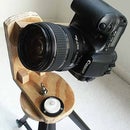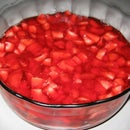Introduction: How to Make Paper Mini's
This is a basic tutorial on the production of 'paper minis' using Heromachine, Hero-O-Matic, or Marvel's Hero Generator to create stand-up figures for your gaming table. What is great about paper mini's is that you can print them color or B&W, you are not stuck with what is in stock because you can make whatever image you want to represent, if they rip or tear, you can print up more, and you dont have to worry about the weight nor the cost of traditional mini's.
Step 1: What You Need
Heromachine
or Hero-O-Matic
or Marvel's Hero Generator
a photo-editing package and any layout design software such as CorelDraw, Adobe Illustrator, InDesign or Publisher.
If you don't have a photo-imaging package you can always download GIMP for free. If you're feeling a little more adventurous, and want to create custom backgrounds for your minis, why not try Inkscape, a free graphics package similar to Illustrator and CorelDraw
The step-by-step instructions assume that you have some familiarity with both the Heromachine/Marvel's/Hero-O-Matic application and your chosen graphics packages. If you do not, spend some time getting yourself familiarized with what you will be using.
Note: Not my video.
Step 2: Maximize Browser
Once you've loaded Heromachine, Hero-O-Matic, or Marvel's Hero Generator and have loaded or designed your hero on screen you need to maximize the browser window to obtain maximum resolution for creating the final image.
This is done because monitors use a much lower resolution than that required to produce high quality images. By making the image as large as possible will allow you to reduce the size of the captured image and therefore increase its resolution.
Step 3: Screen Capture
Make sure that Heromachine(or Hero-O-Matic, or Marvel's) is the current window on your computer and that it is also maximized. To capture the image from the screen read the instructions below.
Note: The clipboard can only hold ONE (1) image at a time. You must paste each screen capture BEFORE taking additional screen captures.
Taking a picture of an active window on your PC (This is the window you are currently working in.)
1) Hold down the {Pic. 1} key and press {Pic. 2}
(the first of 3 buttons to the right of the function keys located along the top of your keyboard).
2) This saves an image of the active window onto the clipboard.
3) Open the file in which you want to place the screen capture.
4) Position your cursor where you want to place the screen capture.
5) Go to the FILE menu and select PASTE.
6) The image will now appear in the location you specified.
Taking a picture of the desktop on your PC (all windows, background, icons, etc.)
1) Press {Pic. 2} (the first of 3 buttons to the right of the function keys located along the top of your keyboard).
2) This saves an image of the active window onto the clipboard.
3) Open the file in which you want to place the screen capture.
4) Position your cursor where you want to place the screen capture.
5) Go to the FILE menu and select PASTE.
6) The image will now appear in the location you specified.
Taking a picture of an active window on your Mac (For example, the contents of your disk.)
Note: a plus sign (+) means to hold keys down together.
1) Press: {Pic. 3}
2) Then hold down {Pic. 4} and click on the window you want to capture.
3) This saves the image to the clipboard.
4) Open the file in which you want to place the screen capture.
5) Position your cursor where you want to place the screen capture.
6) Go to the EDIT menu and select PASTE.
7) The image will now appear in the location you specified.
Taking a picture of a portion of the screen on your Mac (For example, a select group of icons.)
1) Press: {Pic. 5} (*make sure the caps lock is off.)
2) A cross will appear. Draw a box around the section you want holding down the mouse button. Press {Pic. 4} before releasing the mouse button.
3) This saves the image to the clipboard.
4) Open the file in which you want to place the screen capture.
5) Position your cursor where you want to place the screen capture.
6) Go to the EDIT menu and select PASTE.
7) The image will now appear in the location you specified.
Taking a picture of the entire desktop on your Mac (all windows, background, icons, etc.)
1) Press: {Pic. 6}
2)This saves the image to the clipboard.
3) Open the file in which you want to place the screen capture.
4) Position your cursor where you want to place the screen capture.
5) Go to the EDIT menu and select PASTE.
6) The image will now appear in the location you specified.
If there is a way to insert the pictures into the instructable, rather than at the end of the step only, let me know because that would be great.
Step 4: Load Into Graphic Program
Once you've successfully captured the Heromachine window, open up your photo-editing package and Paste the screen capture as a new image. You should have something like this:
Step 5: Crop
The next stage is to crop away all the redundant interface by using the mask tool.
If you're a competent user it may be quicker (and easier) to use the Magic Wand tool to crop off the unwanted areas.
Step 6: Resize and Adjust Resolution
Now that you have your hero cropped out the next step is to adjust the size and resolution of the image to produce the best quality printing output.
Corel Photo-Paints Resample function is used here but most photo-editing packages should have something similar.
Adjust the resolution to 300 dpi (dots per inch) and then 'shrink' the height of the image to your chosen scale. The most commonly occuring scales are 25mm and 28mm.
Note: For micro- or gigantic characters you'll have to adjust the height accordingly.
Once you have completed resizing your character save the file on your hard drive and then make a copy of the file for the next step.
Step 7: Create Silhouette
Using the Magic Wand Mask tool in Subtract(ive) mode select all the white areas of your image ready to Flood Fill with black (or another colour of your choice) to create the character silhouette for the reverse of the miniature.
Step 8: Silhouette 2
Turn the Tolerance/Similarity up to its highest setting and click anywhere within the masked off area. You should have something like this.
Step 9: Silhouette 3
Flip the image horizontally then rotate it through 180ð to produce the correct orientation for the silhouette. Now save this file, ensuring that you don't overwrite the existing full color character!
Step 10: Import Into Layout Package
Now that you have completed all the production steps for your characters image it's time to produce the final layout.
Open up your layout software of choice and import both character files into a new document.
Before you can print out your paper miniature(s) you'll need to create a set of borders/guidelines that will be used in the construction of the mini once it has been printed out.
In order to save ink and paper don't forget to place multiple miniatures on a single page.
Step 11: Draw Border/guidelines
1. Start by drawing a rectangle 25mm wide and Xmm high, where X equals twice the height of your characters graphic plus 35mm. See image below.
Therefore an image of 25mm in height needs a rectangle of [(2 x 25mm) + 35mm] which equals 85mm.
2. Now draw two lines across the width of the box about 12mm - 13mm away from the inside edge of the rectangle. These are the fold-out tabs which will become the miniatures base. See image below.
3. Draw a third line across the middle of the box making sure that it sits across the exact center of the rectangle. This forms the guideline where the fold will go. See image below.
4. Move your colour image into the middle of the box underneath the central line and the silhouette into the box above the dividing line. See below.
5. The final stage of preparation is to add titles to the fold-out tabs located at the top and bottom of the rectangle.
Step 12: Printing, Prolonging
Print onto lightweight card stock, making sure that your printer is set to either Best or Photo to ensure good quality results.
Prolong the life of paper minis by using self-adhesive film (also known as sticky backed plastic).
Cut off a piece of the film large enough to cover the printed card and leave a little extra space around the edges. Peel off the backing and place the film face down on a flat surface. At this point you may want to weight each corner down to prevent the film from lifting.
Take the printout, ensuring the printed side is face down, and, starting with the short edge, roll the card onto the film making sure that you don't twist or pull the card to prevent creases in the film.
Using the back of a spoon, or any similar smooth tool, firmly rub the card onto the film, starting from the center and working your way outwards. Trim off the excess film and 'pop' any bubbles and flatten them out .
Step 13: Preparing the Mini
Use a steel rule, craft knife and cutting mat to cut out the mini(s) taking care not to cut towards yourself. Always cut parallel to your body.
To crease neat folds score lightly along the black lines using either the back of a knife or scissors.
Using paper glue, ensuring that you don't apply any on the 'feet' of the figure, fold the mini over and place a heavy weight on top. Once the adhesive has dried bend out the 'feet' of the mini ready for mounting.
Step 14: Mounting the Miniature
Mounting the paper mini onto a base will give the figure some weight to prevent it from falling over. There are several different mounts that can be employed depending purely upon personal preference. Whichever you choose the process is simple, either glue or tape your mount onto the foldout tabs of the mini, ensuring that mount is at least 25mm x 25mm.
What can be used as a mount you ask?
A thick piece of card; foam core; corrugated card; plastic or metal washers; plastic miniature bases; coins; modeling clay/putty; etc.
Step 15: Finished
Voila! Your paper mini is now ready for the gaming table.
Participated in the
The Instructables Book Contest













